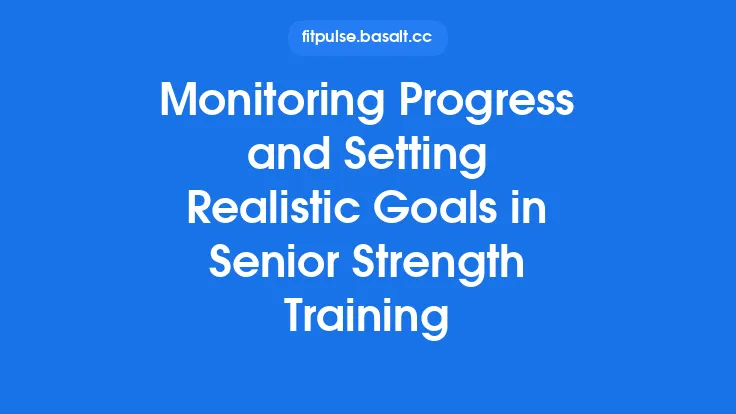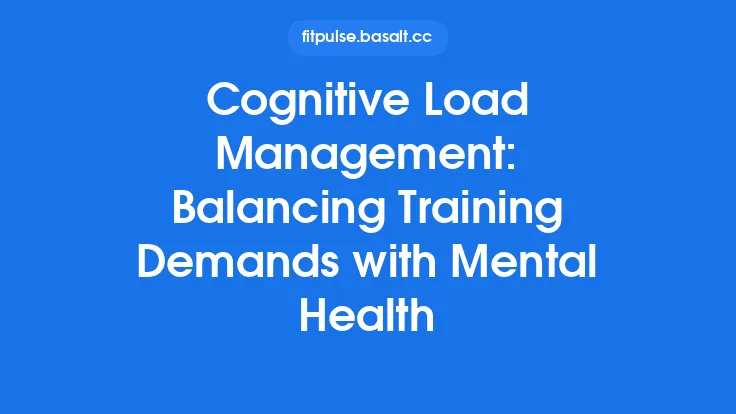Training load—the cumulative stress placed on the body during a workout or over a series of sessions—is a cornerstone of effective, sustainable performance for senior athletes. While the concept itself is timeless, the tools we use to quantify and interpret it have evolved dramatically. Modern wearables now provide a continuous stream of objective data, allowing athletes over 50 to make informed decisions about when to push, when to hold back, and how to progress safely over the long term.
Understanding Training Load: External vs. Internal Components
Training load can be broken down into two complementary dimensions:
- External Load – The work an athlete does (distance covered, power output, repetitions, etc.). This is the mechanical side of training and is typically measured directly by the device’s sensors.
- Internal Load – The physiological response to that work (heart rate, oxygen consumption, muscle activation, perceived exertion). This reflects how the body reacts to the external stimulus.
For senior athletes, the balance between these two components is especially important. Age‑related changes in cardiovascular efficiency, muscle fiber composition, and recovery capacity mean that a given external load may elicit a markedly different internal response compared with a younger counterpart. Wearables that capture both sides of the equation give a more complete picture than any single metric could provide.
Core Wearable Technologies for Load Monitoring
| Technology | Primary Metrics Captured | Typical Placement | Senior‑Specific Benefits |
|---|---|---|---|
| Accelerometers & Gyroscopes | Step count, cadence, impact forces, movement patterns | Wrist, chest strap, shoe | Detect subtle changes in gait or stride that may signal fatigue or early overuse. |
| GPS Modules | Distance, speed, elevation gain, route mapping | Wrist, clip‑on | Quantify volume of outdoor sessions (running, cycling, hiking) without manual logging. |
| Optical Heart Rate Sensors | Continuous HR, HR variability (HRV) | Wrist, chest strap | Offer a non‑invasive window into cardiovascular stress and autonomic balance. |
| Power Meters (cycling, rowing) | Real‑time power output (watts), torque, cadence | Crank, pedal, oar handle | Provide an objective measure of effort that is independent of external conditions (wind, terrain). |
| Electromyography (EMG) Bands | Muscle activation timing, fatigue indices | Upper arm, thigh | Highlight asymmetries or early signs of muscular fatigue that may not be evident in performance. |
| Skin Temperature & Galvanic Sensors | Thermoregulation, sweat response | Wrist, chest | Offer indirect cues about metabolic strain and hydration status. |
Most senior athletes will find a combination of a wrist‑based smartwatch (for HR, HRV, and basic activity tracking) and a sport‑specific sensor (e.g., a bike power meter or a shoe‑mounted accelerometer) sufficient for comprehensive load monitoring.
Translating Raw Data into Meaningful Load Indices
Raw streams of data are only as useful as the context we give them. Several established algorithms convert sensor outputs into actionable load scores:
- Training Impulse (TRIMP) – Calculates load by multiplying session duration by average heart rate, weighted by intensity zones. For seniors, a modified TRIMP that uses a lower maximal HR estimate (e.g., 180 bpm for a 55‑year‑old) yields a more realistic stress value.
- Session Rating of Perceived Exertion (sRPE) × Duration – Combines a subjective 0‑10 effort rating with session length. When paired with objective HR or power data, sRPE helps validate whether perceived effort aligns with physiological stress.
- Acute‑Chronic Workload Ratio (ACWR) – Divides the load of the most recent week (acute) by the average load of the preceding four weeks (chronic). Ratios above 1.5 may indicate a heightened risk of overreaching, while ratios below 0.8 could suggest under‑training.
- Power‑Based Normalized Load – For cyclists and rowers, normalizing power output to body mass (W·kg⁻¹) and integrating over time (kJ) provides a load metric that accounts for individual size differences.
By consistently applying one or two of these indices, senior athletes can track trends rather than isolated spikes, which is crucial for long‑term adaptation.
Building an Individualized Load Management Plan
1. Establish Baseline Profiles
- Week 1–2: Record all training sessions without altering intensity. Capture external (distance, power) and internal (HR, HRV) data.
- Analyze Variability: Compute mean and standard deviation for each metric. Identify natural fluctuations (e.g., higher HRV on rest days).
2. Define Target Load Ranges
- Acute Load Goal: Set a weekly TRIMP or power‑kJ target that sits at 70‑85 % of the baseline average. This provides a modest stimulus while respecting recovery capacity.
- Chronic Load Buffer: Maintain a rolling four‑week average that is 10‑15 % higher than the acute goal, ensuring a gradual progression.
3. Implement Real‑Time Alerts
- Many platforms allow custom thresholds (e.g., “Notify if HR exceeds 85 % of age‑predicted max for more than 5 min”). Use these alerts to pause or modify a session before excessive strain accumulates.
4. Review and Adjust Weekly
- Post‑Session Review: Compare actual load to planned load. If the ACWR exceeds 1.5, schedule a low‑intensity recovery day.
- Monthly Re‑calibration: Update baseline values to reflect fitness gains or lifestyle changes (e.g., new medication affecting HR response).
Practical Tips for Senior Athletes Using Wearables
- Prioritize Comfort: Sensors that irritate the skin or feel heavy can lead to inconsistent wear. Opt for breathable straps and lightweight devices.
- Sync Regularly: Automatic cloud syncing prevents data loss and ensures that trend analyses are up‑to‑date.
- Validate Sensor Accuracy: Periodically cross‑check wearable HR against a chest strap or manual pulse count, especially after firmware updates.
- Simplify Data Views: Use dashboards that highlight the most relevant metrics (e.g., weekly TRIMP, ACWR, HRV trend) rather than overwhelming charts.
- Integrate with Coaching Software: If you work with a coach, share raw data files (CSV, FIT) so they can apply their own analytical models.
Data Privacy and Ethical Considerations
Wearable ecosystems collect highly personal health information. Senior athletes should:
- Read Privacy Policies: Understand how data is stored, who can access it, and whether it is sold to third parties.
- Enable Encryption: Use devices that support end‑to‑end encryption for data transmission.
- Control Sharing Settings: Limit data sharing to only those platforms or individuals necessary for performance analysis.
- Maintain Backups: Export raw data periodically to a secure personal storage solution (e.g., encrypted external drive).
Limitations of Wearable‑Based Load Monitoring
While wearables are powerful, they are not infallible:
- Sensor Drift: Over time, accelerometer calibration can shift, leading to inaccurate impact counts.
- Environmental Interference: GPS accuracy degrades in dense urban canyons or heavy foliage, affecting distance metrics.
- Physiological Variability: Factors such as caffeine intake, stress, or medication can alter HR and HRV independent of training load.
- Data Overload: Excessive metrics can obscure the most relevant signals, leading to analysis paralysis.
Recognizing these constraints helps senior athletes maintain a balanced perspective and avoid over‑reliance on any single data point.
Emerging Trends and Future Directions
- Multimodal Sensor Fusion: Next‑generation devices combine accelerometry, ECG‑grade heart monitoring, and near‑infrared spectroscopy to estimate muscle oxygenation in real time, offering a direct glimpse into metabolic load.
- AI‑Driven Predictive Modeling: Machine‑learning algorithms can forecast fatigue or performance dips days in advance by analyzing historical load patterns, sleep data, and lifestyle inputs.
- Adaptive Feedback Loops: Wearables that automatically adjust training recommendations (e.g., suggesting a lower intensity based on elevated HRV) are moving from research prototypes to consumer products.
- Biomechanical Mapping: Integrated pressure sensors in insoles or smart clothing can detect subtle gait changes that precede overuse injuries, allowing preemptive load adjustments.
Staying informed about these developments ensures that senior athletes can adopt new tools as they become reliable and cost‑effective.
Summary
Monitoring training load with wearables equips senior athletes with a data‑driven framework to balance performance gains against the natural physiological changes that accompany aging. By capturing both external work and internal response, translating raw signals into validated load indices, and applying a structured, individualized management plan, athletes over 50 can train smarter, stay healthier, and enjoy longer competitive careers. The key lies in selecting appropriate sensors, interpreting trends rather than isolated numbers, respecting privacy, and remaining aware of each technology’s limitations. As wearable technology continues to mature, the potential for even more precise, personalized load monitoring will only grow—offering senior athletes an ever‑more powerful ally in the pursuit of lifelong sport excellence.





